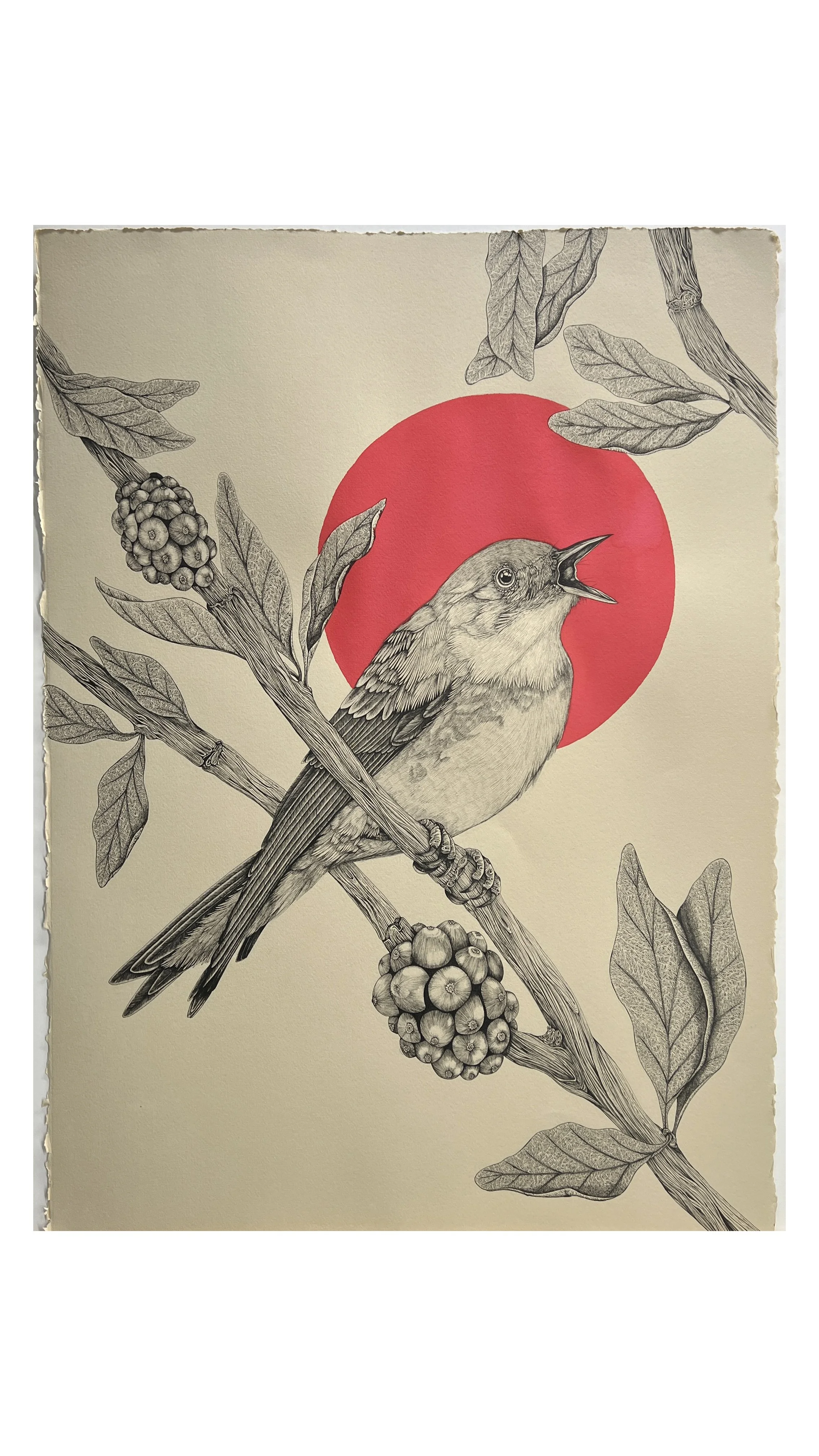The Cerulean Warbler
Researching and studying the migratory path of birds in the Mississippi Flyway has inspired my art and provided a voice and context that visually manifests as statements about the health and vitality of bird species and their habitats. My goal with this warbler series is to highlight birds that are both beautiful and undergoing significant changes to their environments, migratory patterns, and habitats. As I read more about the threatened bird species that are critical to support, I noted many warblers. In fact, there were so many that it was challenging to choose one on which to focus my attention. The Cerulean Warbler captured my interest for several reasons. First, it is a beautifully colored bird with a call that matches its appearance. Secondly, it is possibly threatened or endangered due to habitat loss. The Cerulean Warbler thrives when forest and canopy areas are concentrated in habitats of 700+ acres. Studies have shown that the migratory path of this warbler within the Mississippi Flyway continues to shift northward into Canada and sees a decline in habitat populations in areas of the U.S. dominated by crop fields. Additionally, their southern migratory route is changing with the rise of sun-crop coffee plantations in South America.
Migratory Path
https://abcbirds.org:
Over 80 percent of the Cerulean Warbler population breeds in the forests of the Appalachians, inhabiting the canopy of mature forests that include a diverse mix of mid-story and shrub vegetation. These fecund forests provide breeding habitat for a wide variety of life, including other Neotropical migrants such as the Ovenbird, Wood Thrush, and Canada Warbler.
The Cerulean Warbler migrates long distances to winter in Andean mountain forests from Colombia south to Bolivia. Coffee grown under the shade of native trees, often called shade-grown coffee, can also provide important wintering habitat for this species. (Find out about Bird Friendly coffee and how it helps migratory birds.)
Early migrants, Ceruleans leave their breeding grounds before many other species do, often reaching their winter range by late August.
Research on coffee crops and the impact of biodiversity was done in 1996 by Ivette Perfecto, Robert A. Rice, Russell Greenberg, and Martha E. Van der Voort. “Shade Coffee: A Disappearing
Refuge for Biodiversity” where the authors reported on research and ”The importance of shade coffee as a refuge for biodiversity may not be in the total land it involves, but in its location in areas that have been particularly hard hit by deforestation.” And in South America, most of the deforestation impact on the Cerulean warbler potential habitat is due to sun coffee crops. (Read more here). Since publishing, there as been new efforts to move back toward shade coffee crops that thrive and mature more slowly under forested canopy. While having less yield and a longer growing season, the coffee plants require less water and can be grown without pesticides and herbicides. They also require less cost with reduction of hours spend applying these chemicals. You can find bird friendly coffee by searching for “bird friendly” or/and “fair trade” brands.
The Cerulean
Warbler
Status
Read more here >
Bringing all this to my art was done through many explorations of composition. My goal with this art is to highlight the impact of sun coffee crops on biodiversity, the beauty of the cerulean warbler species and to remind us how connected nature and humans are. Sharing below my personal sketchbook explorations to combine elements as symbols to the larger conversation agriculture has on biodiversity, the push and pull of humans impact on nature and also our efforts to save it.
At the time of this entry, I’ve completed to finished ink drawings: Cerulean I and Cerulean II > The Cerulean warbler is placed on a coffee plant branch with the sun behind it. The sun is larger and overpowering which speaks to this type of coffee crop impact on biodiversity and also the environmental threat of it’s loss of habitat, for the coffee plan is no home for its nest. Both works are drawn on neutral toned 100% cotton printmaking paper with archival black ink and accented with color ink wash. Cerulean I features a mango color ink wash for the sun. Brilliant and intense but speaks to a possible threat to the warbler. Cerulean II features has a red sun which signifies an ever increasing threat the sun coffee crops have on its environment. While this warbler has a beautiful sound, the open beak is rendered more like a call to action, for the viewer to take notice and create dialogue on this topic. I have plans to continue this series and allow it to evolve to other warbler species with their specific habitat symbolically represented.
Cerulean I and Cerulean II:




















